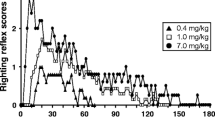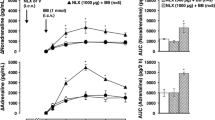Abstract
Several studies have demonstrated a paradoxical form of antinociception induced by the repeated administration of opioid antagonists accompanied by exposure to a painful stimulus. The underlying mechanism of this naloxone-induced antinociception (NIA) is still unknown, but the results of several studies suggest that it is a non-opioid response. This study was designed to investigate serotonergic and noradrenergic involvement in NIA. Rats were treated daily with systemic injections of 5 mg/kg naloxone, followed by a 45-s hot plate test of nociception (temperature=51.5 ± 0.5°C). After rats reached plateau levels of NIA, they received a test trial in which they were treated with various doses of different selective 5-HT or α2 adrenoceptor antagonists in addition to naloxone before the hot plate test. Rats treated with 0.16, 0.32 and 0.63 mg/kg pirenperone or 2.5 mg/kg ritanserin showed significant reductions in paw lick latency with respect to rats treated with vehicle. In addition, high doses of yohimbine (7.5–10 mg/kg) also effectively reversed NIA. In contrast, NIA was not affected by acute blockade of 5-HT1 or 5-HT3 receptors by methiothepin or MDL 72222, respectively, or by the α2 adrenoceptor blocker idazoxan. None of the 5-HT or α2 adrenoceptor antagonists had any effect on the paw lick latencies of saline-treated rats. A possible role of 5-HT2 receptors in the antinociception induced by opioid receptor blockade is discussed.
Similar content being viewed by others
References
Amit Z, Galina ZH (1986) Stress-induced analgesia: adaptive pain suppression. Physiol Rev 66:1091–1120
Besson JM (1990) Serotonin and pain. Elsevier, Amsterdam
Bodnar RJ (1986) Neuropharmacological and neuroendocrine substrates of stress-induced analgesia. Ann NY Acad Sci 467:345–360
Bodnar RJ (1990) Effects of opioid peptides on peripheral stimulation and “stress”-induced analgesia in animals. Crit Rev Neurobiol 6:39–49
Bodnar RJ, Merrigan KP, Sperber E (1983) Potentiation of cold-water swim analgesia and hypothermia by clonidine. Pharmacol Biochem Behav 19:447–451
Cappell H, Knoke DM, Le AD, Poulos CX (1989a) Naloxone-induced analgesia: effects of the benzodiazepine antagonist Ro 15–1788. Pharmacol Biochem Behav 34:197–200
Cappell H, Poulos CX, Le AD (1989b) Enhancement of naloxone-induced analgesia by pretreatment with morphine. Pharmacol Biochem Behav 34:425–427
Chance WT (1979) Autoanalgesia: opiate and non-opiate mechanisms. Neurosci Biobehav Rev 4:55–67
Chance WT (1986) The role of brain and spinal cord norepinephrine in autoanalgesia. Ann NY Acad Sci 467:309–330
Coderre TJ, Rollman GB (1984) Stress analgesia: effects of PCPA, yohimbine, and naloxone. Pharmacol Biochem Behav 21:681–686
Colpaert FC, Niemegeers CJE, Janssen PAJ (1982) A drug discrimination analysis of lysergic acid diethylamide (LSD): in vivo agonist and antagonist effects of purported 5-hydroxytryptamine antagonists and of pirenpirone, a LSD antagonist. J Pharmacol Exp Ther 221:206–214
Colpaert FC, Meert TF, Niemegeers CJE, Janssen PAJ (1985) Behavioral and 5-HT antagonist effects of ritanserin: a pure and selective antagonist of LSD discrimination in rat. Psychopharmacology 86:45–54
Doxey JC, Lane AC, Roach AG, Virdee NK (1984) Comparison of the alpha-adrenoceptor antagonist profiles of idazoxan (RX 781094), yohimbine, rauwolscine and corynanthine. Naunyn-Schmiedeberg's Arch Pharmacol 325:136–144
El-Yassir N, Fleetwood-Walker SM, Mitchell R (1988) Heterogeneous effects of serotonin in the dorsal horn of rat: the involvement of 5-HT1 receptor subtypes. Brain Res 456:147–158
Fields HL, Heinricher MM, Mason P (1991) Neurotransmitters in nociceptive modulatory circuits. Annu Rev Neurosci 14:219–245
Fisher MC, Bodnar RJ (1992) 2-Deoxy-D-glucose antinociception and serotonin receptor subtype antagonists: test-specific effects in rats. Pharmacol Biochem Behav 43:1241–1246
Foo H, Westbrook RF (1991a) Naloxone-induced analgesia: effects of heat, cold and novelty. Q J Exp Psychol [B] 43:137–156
Foo H, Westbrook RF (1991b) Naloxone-induced hypoalgesia: effects of noradrenergic antagonists and agonist. Pharmacol Biochem Behav 39:795–797
Fozard JR (1984) MDL 72222, a potent and highly selective antagonist at neuronal 5-hydroxytryptamine receptors. Naunyn-Schmiedeberg's Arch Pharmacol 326:36–44
Glaum SR, Proudfit HK, Anderson EG (1988) Reversal of the antinociceptive effects of intrathecally administered serotonin in the rat by a selective 5-HT3 receptor antagonist. Neurosc. Lett 95:313–317
Glaum SR, Proudfit HK, Anderson EG (1990) 5-HT3 receptors modulate spinal nociceptive reflexes. Brain Res 510:12–16
Goldberg MR, Robertson D (1983) Yohimbine: a pharmacological probe for study of the alpha-2-adrenoreceptor. Pharmacol Rev 35:143–180
Greeley JD, Westbrook RF (1990) Effects of exposure to a heat stressor upon the rat's subsequent reactions to that stressor. Q J Exp Psychol [B] 42:1–40
Greeley JD, Le AD, Poulos CX, Cappell H (1988) “Paradoxical” analgesia induced by naloxone and naltrexone. Psychopharmacology 96:36–39
Hammon M, Collin E, Chantrel D, Daval G, Verge D, Bourgoin S (1990) Serotonin receptors and the modulation of pain. In: Besson JM (ed) Serotonin and pain. Elsevier, Amsterdam, pp 31–52
Hammond DL (1990) Role of serotonergic systems in morphine-induced antinociception. In: Besson JM (ed) Serotonin and pain. Elsevier, Amsterdam, pp 251–261
Hartig PR, Hoffman BJ, Kaufman MJ, Hirata F (1990) The 5-HT1C receptor. Ann NY Acad Sci 600:149–166
Hasegawa Y, Kurachi M, Okuyama S, Araki H, Otomo S (1990) 5-HT3 receptor antagonists inhibit the response of K opioid receptors in the morphine-reduced Straub tail. Eur J Pharmacol 190:399–401
Hensman R, Guimaraes FS, Wang FS, Deakin JFW (1991) Effects of ritanserin on aversive classical conditioning in humans. Psychopharmacology 104:220–224
Ho BY, Takemori AE (1990) Attenuation of the antinociceptive action of the selective K-opioid receptor agonist U50, 488H by ICS205930. Eur J Pharmacol 178:371–373
Hutson PH, Curzon G, Tricklebank MD (1984) Anti-nociception induced by brief footshock: characteristics and roles of 5-hydroxytryptamine and dopamine. In: Tricklebank MD, Curzon G (eds) Stress-induced analgesia. Wiley, London, pp 135–164
Jackson HC, Griffin IJ, Nutt DJ (1991) The effects of idazoxan and other alpha-2-adrenoceptor antagonists on food and water intake in the rat. Br J Pharmacol 104:258–262
Jensen TS, Yaksh TL (1986) II. Examination of spinal monoamine receptors through which brainstem opiate-sensitive systems act in the rat. Brain Res 363:114–127
Kepler KL, Bodnar RJ (1988) Yohimbine potentiates cold-water swim analgesia: re-evaluation of a noradrenergic role. Pharmacol Biochem Behav 29:83–88
Kiefel JM, Paul D, Bodnar RJ (1989) Reduction in opioid and non-opioid forms of swim analgesia by 5-HT2 receptor antagonists. Brain Res 500:231–240
Kiefel JM, Cooper ML, Bodnar RJ (1991) Inhibition of mesencephalic morphine analgesia by methysergide in the medial ventral medulla of rats. Physiol Behav 51:201–205
Leysen JE, Awouters F, Kennis L, Laduron PM, Vandenderk J, Janssen PAJ (1981) Receptor binding profile of R 41 486, a novel antagonist at 5-HT2 receptors. Life Sci 28:1015–1022
Leysen JE, Gommeren W, Van Gompel P, Wynants J, Janssen PAJ, Laduron PM (1985) Receptor binding properties in vitro and in vivo of ritanserin. Mol Pharmacol 27:600–611
Meert TF, Janssen PAJ (1989) Psychopharmacology of ritanserin: comparison with chlordiazepoxide. Drug Dev Res 18:119–144
Michel MC, Insel PA (1989) Are there multiple imidazoline binding sites? TIPS 101:342–344
Millan MJ, Colpaert FC (1991a) 5-Hydroxytryptamine (5-HT)1A receptors and the tail-flick response. II. High efficacy 5-HT1A agonists attenuate morphine-induced antinociception in mice in a competitive-like manner. J Pharmacol Exp Ther 256:983–993
Millan MJ, Colpaert FC (1991b) 5-hydroxytryptamine (5-HT)1A receptors and the tail-flick response. III. Structurally diverse 5-HT1A partial agonists attenuate mu- but not kappa-opioid antinociception in mice and rats. J Pharmacol Exp Ther 256:993–1001
Millan MJ, Bervoets K, Colpaert FC (1991) 5-Hydroxytryptamine (5-HT)1A receptors and the tail-flick response. I. 8-hydroxy-2-(di-n-propylamino)tetralin HBr-induced spontaneous tail-flicks in the rat as an in vivo model of 5-HT1A receptor-mediated activity. J Pharmacol Exp The. 256:973–982
Minor BG, Danysz W, Post C, Jonsson G, Su E, Archer T (1988) Noradrenergic and serotonergic involvement in brief shock-induced analgesia in rats. Behav Neurosci 102:915–924
Minor BG, Danysz W, Jonsson G, Mohammed AK, Post C, Archer T (1989) Adaptive changes in alpha-2 adrenoceptor mediated responses: analgesia, hypothermia and hypoactivity. Pharmacol Toxicol 65:143–151
Nelson DL, Herbet A, Pichat L, Glowinski J, Hammon M (1979) In vitro and in vivo disposition of3H-methiothepin in brain tissues. Naunyn-Schmiedeberg's Arch Pharmacol 310:25–33
Onaivi ES, Martin BR (1989) Neuropharmacological and physiological validation of a computer-controlled two-compartment black and white box for the assessment of anxiety. Prog Neuropsychopharmacol Biol Psychiatry 13:963–976
Paul D, Phillips AG (1986) Selective effects of pirenpirone on analgesia produced by morphine or electrical stimulation at sites in the nucleus raphe magnus and periaqueductal grey. Psychopharmacology 88:172–176
Paul D, Mana MJ, Pfaus JG, Pinel JPL (1989) Attenuation of morphine analgesia by the serotonin type-2 receptor blockers, pirenpirone and ketanserin. Pharmacol Biochem Behav 31:641–647
Poulos CX, Knoke DM, Le AD, Cappell H (1990) Naloxone-induced analgesia and morphine supersensitivity effects are contingent upon prior exposure to analgesic testing. Psychopharmacology 100:87–103
Roberts MHT (1984) 5-Hydroxytryptamine and antinociception. Neuropharmacology 33:1529–1536
Rochford J, Dawes P (1992) Clonidine and yohimbine modulate the effects of naloxone on novelty-induced hypoalgesia. Psychopharmacology. 107:575–580
Rochford J, Stewart J (1987) Activation and expression of endogenous pain control mechanisms in rats given repeated nociceptive tests under the influence of naloxone. Behav Neurosci 101:87–103
Rochford J, Dube B, Dawes P (1992) Spinal cord alpha-2 noradrenergic receptors mediate conditioned analgesia. Psychopharmacology 106:235–238
Rochford J, Dawes P, Stewart J (1993) Naloxone potentiation of novelty-induced hypoalgesia: Characterization of the alpha-noradrenergic receptor subtype. Pharmacol Biochem Behav 44:381–386
Schoeffter P, Hoyer D (1991) Interaction of the alpha-adrenoceptor agonist oxymetazoline with serotonin 5-HT1A, 5-HT1B, 5-HT1C and 5-HT1D receptors. Eur J Pharmacol 196:213–216
Schotte A, de Bruyckere K, Janssen PFM, Leysen JE (1989) Receptor occupancy by ritanserin and risperidone measured using ex vivo autoradiography. Brain Res 500:295–301
Tjolsen A, Berge O-G, Eide PK, Broch OJ, Hole K (1988) Apparant hyperalgesia after lesions of the descending serotonergic pathways is due to increased tail skin temperature. Pain 33:225–231
Vasko MR, Pang I-H, Vogt M (1984) Involvement of 5-hydroxytryptamine-containing neurons in antinociception produced by injection of morphine into nucleus raphe magnus or onto spinal cord. Brain Res 306:341–348
Walker MJK, Le AD, Poulos CX, Cappell H (1991a) Chronic selective blockade of mu opioid receptors produces analgesia and augmentation of the effects of a kappa agonist. Brain Res 538:181–186
Walker MJK, Le AD, Poulos CX, Cappell H (1991b) Role of central versus peripheral opioid receptors in analgesia induced by repeated administration of opioid antagonists. Psychopharmacology 104:164–166
Walker MJK, Le AD, Poulos CX (1992) Effects of naltrindole and nor-binaltorphimine treatment on antinociception induced by sub-acute selective mu opioid receptor blockade. Brain Res 599:204–208
Watkins LR, Mayer DJ (1982) Organization of endogenous opiate and nonopiate pain control systems. Science 216:1185–1192
Westbrook RF, Greeley JD (1990) Some effects of the opioid antagonist, naloxone, upon the rat's reactions to a heat stressor. Q J Exp Psychol [B] 42:1–40
Wigdor S, Wilcox GL (1987) Central and systemic morphine-induced antinociception in mice: contribution of descending serotonergic and noradrenergic pathways. J Pharmacol Exp Ther 24:290–295
Author information
Authors and Affiliations
Rights and permissions
About this article
Cite this article
Katharine Walker, M.J., Poulos, C.X. & Le, A.D. Effects of acute selective 5-HT1, 5-HT2, 5-HT3 receptor andα 2 adrenoceptor blockade on naloxone-induced antinociception. Psychopharmacology 113, 527–533 (1994). https://doi.org/10.1007/BF02245234
Received:
Revised:
Issue Date:
DOI: https://doi.org/10.1007/BF02245234




